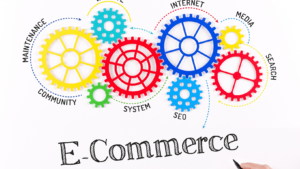In the ever-evolving digital world, e-commerce has become a vital cog in the wheel of global business. This model, where businesses provide goods and services directly to individuals, has revolutionized the way we shop, trade, and interact.
This article delves into the heart of this e-commerce model where businesses provide goods and services to individuals, exploring its nuances, benefits, and challenges. It’s a fascinating journey that uncovers how businesses are leveraging technology to reach out to customers, breaking geographical barriers, and transforming the global marketplace.
So, whether you’re an entrepreneur looking for insights or a curious reader intrigued by the digital revolution, this piece will provide a comprehensive understanding of the e-commerce model that’s reshaping the business landscape.
E-commerce Model Where Businesses Provide Goods And Services To Individuals
 Let’s delve deeper into the fascinating world of e-commerce model where businesses provide goods and services to individuals, understanding its definition and identifying its key characteristics.
Let’s delve deeper into the fascinating world of e-commerce model where businesses provide goods and services to individuals, understanding its definition and identifying its key characteristics.
E-commerce, an abbreviation for electronic commerce, signifies the buying and selling of goods, services, or information over the Internet. It’s a model that includes businesses marketing to individuals – often called Business to Consumer (B2C) transactions. Examples serve to clarify: renowned businesses like Amazon, Walmart, and Apple operate on this B2C model, directly providing goods and services to individuals via their online platforms.
Key Characteristics
E-commerce presents several distinguished characteristics:
-
Online Presence: Businesses maintain an online storefront, showcasing products or services that consumers can survey and purchase 24/7.
-
Global Reach: E-commerce breaks down geographical barriers, allowing businesses to cater to customers worldwide. Amazon’s global customer base dictates an example here.
-
Payment Systems: Implement an array of online payment systems, such as credit or debit cards, PayPal, or mobile payments. Examples include Apply Pay or Google Pay.
-
Personalization: E-commerce platforms utilize user data to offer personalized experiences and recommendations. For example, Netflix uses viewing history data to suggest tailored content.
-
Convenience and Efficiency: E-commerce offers ease to customers who can shop anywhere, anytime, typically with faster delivery times. Amazon Prime’s two-day shipping exemplifies this aspect.
Understanding these characteristics and how they’re incorporated into an operational e-commerce model where businesses provide goods and services to individuals propels businesses towards effective digital transition and success.
Business-to-Consumer (B2C) Models
 Within the realm of e-commerce, the Business-to-Consumer (B2C) model holds significant prominence. Essentially, it encapsulates transactions between a business and its end consumers.
Within the realm of e-commerce, the Business-to-Consumer (B2C) model holds significant prominence. Essentially, it encapsulates transactions between a business and its end consumers.
Among B2C platforms, Amazon, eBay, and Alibaba stand as prime examples. Amazon, a United States-based e-commerce giant, offers a plethora of products ranging from books to electronics. eBay, another salient platform, allows businesses to auction their goods to consumers. Alibaba, originating in China, spearheads a similar approach, offering a myriad of items for purchase.
Advantages of B2C E-commerce
The B2C_ecommerce domain offers manifold advantages. Firstly, it increases market reach. Businesses, regardless of their geographical location, can cater to a global customer base. Secondly, it introduces simplified business processes. Automated online systems streamline operations, making transactions quicker and efficient. Finally, it grants access to customer data, supplying businesses with vital information to optimize marketing strategies and improve customer service.
How E-commerce Serves Individuals
 E-commerce, rooted in convenience and efficiency, is tailored to serve individuals. It becomes a personal assistant, from personalizing their experience to enhancing customer service.
E-commerce, rooted in convenience and efficiency, is tailored to serve individuals. It becomes a personal assistant, from personalizing their experience to enhancing customer service.
E-commerce platforms tune their offerings for individuals, based on their buying patterns and preferences. This personalization includes recommendations tailored to customers’ tastes on platforms like Amazon, eBay, and Alibaba. For instance, if a customer regularly purchases fitness gear, the platform may suggest new energy drinks or workout clothes that others have bought. These intelligent suggestions are achieved using predictive analytics that map customers’ creativity.
The Role of Customer Service
In an online marketplace, customer service takes on a pivotal role. Attending to customer grievances, handling product return and replacements, or assisting in navigating the platform – these are just a few tasks customer service carries out in the e-commerce model. For example, Amazon’s 24/7 customer service provides instant help to customers, answering queries through live chats, calls, or emails.

